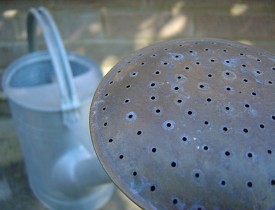Garden Irrigation Methods, Ranked by Efficiency
 A properly watered garden is one step closer to being a healthy garden. However, there are many ways to water a garden, some of which will not only save you time and labor, but also help conserve water. The following is a list of different methods, ranked in order of efficiency, and a description of each.
A properly watered garden is one step closer to being a healthy garden. However, there are many ways to water a garden, some of which will not only save you time and labor, but also help conserve water. The following is a list of different methods, ranked in order of efficiency, and a description of each.
Deep Soak Methods
Deep soak methods use 50% less water for the same effectiveness as some other watering methods. They keep the roots moist and avoid wet foliage.
1. Drip Tape/Drip Line
Drip lines have a higher initial cost for equipment and take time to set up, but once they are laid out they are the most efficient in terms of water use and time spent on landscape maintenance. They usually only need to be turned on once or twice a week for about an hour or two at a time and can be set on a timer. They may also be concealed under mulch or soil, if aesthetics are an issue.
2. Weeping Line/Soaker Hose
These are porous hose lines. They are different from drip lines in that while a drip line has evenly spaced watering points, a soaker hose is completely porous so that water sweats out of it all along the length of the hose. As with a drip line, the slow soaking prevents evaporation and runoff, but a soaker hose is easier to move than a drip line. Overall, this is a very efficient method of watering.
Hand Watering
The benefit of hand watering is that it allows you to water directly at the base of your plants instead of broadcasting water where you don't need it. Often this wasteful broadcasting just encourages weeds to grow. However, hand watering requires your labor and time each time you need to water.
3. Water Wand
All around, the water wand is the most efficient and convenient low-tech tool for hand watering. It's a hose attachment, extending as a solid pipe a few feet from the end of the hose with a breaker (a sieve-style nozzle) at its end. They provide a soft, rain-like stream of water which is gentler on the soil. In addition, its extended neck permits you to water directly at the base of plants without bending over. Many water wands come with a pressure valve which allows you to change the water pressure at the flip of the thumb. Dramm makes one of the best water wands, with a brass pressure valve.
4. Watering Can
The can has some of the same benefits as the wand, in that it allows direct-point watering and a rain-like stream of water. However, a full watering can tends to be heavy to carry and will require more bending on your part to direct the water to the base of plants. Plastic watering cans are less expensive and a bit lighter, but will not last as long as their galvanized metal counterparts.
5. Unmodified Hose
The problem with using an unmodified hose is that the single stream of water tends to remove topsoil, exposing plant roots, and since it has no pressure valve, frequently wastes water. Trust me, if you're already using a hose to water, it is totally worth investing in a water wand.
Sprinklers
Sprinklers are convenient for broadcasting water over a wide area, like a lawn. But they are the least efficient method in the garden.
6. Portable Sprinkler
The portable sprinkler is the least efficient of all these watering methods. Water is lost to areas that don't need moisture to begin with, not to mention the extra water wasted through evaporation. Since they broadcast water on plant leaves, they also tend to promote plant disease on some vegetables. They're convenient in the sense that you can turn them on and leave them alone while they water, but if convenience is what you're looking for, a drip line or soaker hose is a better investment.
Jordan Laio writes for networx.com.
Updated April 10, 2018.
Looking for a Pro? Call us (866) 441-6648

Landscaping Average Costs
Landscapers Experiences

Fast Professional Tree Service For My Crabapple And Persimmon

Lawn Repair: Contractor Followup To My DIY Prep Got The Job Done



